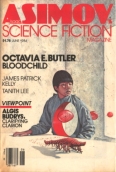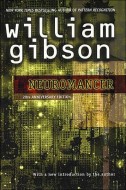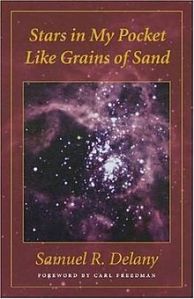Some of the notable short speculative fiction:
Gene Wolfe’s A Cabin on the Coast
Octavia E. Butler’s Bloodchild, which won the Hugo Award for best novelette
David Brin’s The Crystal Spheres, which won the Hugo Award for best short story (1985). Within the story, Brin presents a possible explanation for the Fermi Paradox
John Varley’s PRESS ENTER, which won the Hugo for best novella
George Alec Effinger’s The Aliens Who Knew, I Mean, Everything
Gardner Dozois’s Morning Child, which won the Nebula Award for best short story
Lucius Shepard’s Salvador, which won the Locus Poll award for Best Short Story and the SF Chronicle award for Short Story
Some of the movies and television of 1984:
The Transformers, the cartoon series that launched a franchise that is still spitting out movies.
Highway to Heaven, a fluffy, feel-good series about an angel that helps troubled people overcome difficulties.
2010, which wasbased on Arthur C. Clarke’s 2010: Odyssey Two, a sequel to the wonderful 2001: A Space Odyssey (1968). 2010 was not as powerful as the original.
Dune, based on Frank Herbert’s novel. Read the book.
Ghostbusters, a ‘paranormal’ comedy that was loved by critics and the general audience.
Star Trek III: The Search for Spock. I loved the original series when it was first broadcasted (yes, I’m that old!), but I was never a fan of the movies.
Some of the notable novels of 1984:
Vernor Vinge’s Peace War, which is about a group of scientist who invent an apparatus that is capable of producing an impenetrable force field. The scientist use the apparatus to end warfare: a force field is produced around any group that endangers peace, and the scientists prohibit technological progress in a bid to maintain control. A group of rebels discover that the force fields are actually stasis fields; within the spherical fields, time is frozen. Additionally, the fields collapse after a specific time has elapsed. As usual, Vernor Vinge has created an intriguing story. The novel has two sequels: The Ungoverned (a 1985 novella), and Marooned in Realtime (a 1986 novel). Across Realtime is an omnibus edition that contains all three stories.
Octavia E. Butler’s Clay’s Ark, a book in her Patternmaster series (each book can be enjoyed as a stand-alone): Patternmaster (1976), Mind of My Mind (1977), Wild Seed (1980), and Clay’s Ark (1984): the series is available in an omnibus edition, Seed to Harvest. The series depicts a secret history, beginning in ancient Egypt and extending into the far future and involves eugenics, an extraterrestrial plague (the clay ark disease), and telepathic mind control. It is interesting to study the evolution in the writer’s craft as the series develops.
Robert Holdstock’s Mythago Wood, which won the BSFA Award and the world Fantasy Award (a tie). Mythago Wood began as a short story (1979), was expanded slightly to a novella (1981), and was eventually worked into a novel that spawned a series, the Mythago Wood cycle (aka the Ryhope Wood series). The novel is set in England, by a fictional forest (the Ryhope Wood), just after WW II. After recovering from injuries sustained in the war, Stephen Huxley returns to his childhood home where his older brother Christian now lives (both parents have passed away). The brothers had often seen mythagos in Ryhope Woods, but their father had told them they were only peripatetic gypsies. However, their father, George Huxley, had been secretly studying the woods, and he’d kept thorough records of his adventures. Christian followed in his father’s footsteps, and Stephen eventually realizes that the mythagos are real. It is a wonderfully rendered fantasy world; the prose paints enigmatic tones, and English, Celtic and Welsh mythology are woven into the tale. A classic.
 William Gibson’s Neuromancer, a cyberpunk novel that defined the genre: it was the first novel to win the Nebula, Hugo, and PK Dick Awards. The novel is the first book in the Sprawl trilogy (Neuromancer, Count Zero (1986) and Mona Lisa Overdrive (1988)), and is set in the dystopian, criminal districts of Japan’s Chiba City. The story follows Henry Dorsett Case: at one time, he was a gifted computer hacker (a cowboy, a rustler), but as the novel begins, he has been reduced to a life as a bottom-feeding hustler because he had the audacity to cheat powerful people. Case is approached by Molly Millions (first introduced in Gibson’s short story Johnny Mneumonic); Molly is a street samurai, and is working as a mercenary for Armitage, a shady ex-military man. Armitage promises Case a pathway out of his dismal existence, but Case must successfully complete a hacking job first. The plot is trite and jarringly convoluted, but the writing is dense and exciting; Neuomancer may not seem revolutionary today, but it was instrumental in the explosive acceptance of a new sub-genre, which was dismissed as yesterday’s news by many writers shortly after it was born, yet still survives as a sub-genre thirty years later.
William Gibson’s Neuromancer, a cyberpunk novel that defined the genre: it was the first novel to win the Nebula, Hugo, and PK Dick Awards. The novel is the first book in the Sprawl trilogy (Neuromancer, Count Zero (1986) and Mona Lisa Overdrive (1988)), and is set in the dystopian, criminal districts of Japan’s Chiba City. The story follows Henry Dorsett Case: at one time, he was a gifted computer hacker (a cowboy, a rustler), but as the novel begins, he has been reduced to a life as a bottom-feeding hustler because he had the audacity to cheat powerful people. Case is approached by Molly Millions (first introduced in Gibson’s short story Johnny Mneumonic); Molly is a street samurai, and is working as a mercenary for Armitage, a shady ex-military man. Armitage promises Case a pathway out of his dismal existence, but Case must successfully complete a hacking job first. The plot is trite and jarringly convoluted, but the writing is dense and exciting; Neuomancer may not seem revolutionary today, but it was instrumental in the explosive acceptance of a new sub-genre, which was dismissed as yesterday’s news by many writers shortly after it was born, yet still survives as a sub-genre thirty years later.
Barry Hughart’s Bridge of Birds, which won the world Fantasy Award (a tie). Subtitled A Novel of an Ancient China That Never Was, it is the first tale of Number Ten Ox, a robust young man and the story’s narrator, and Master Li Kao, who has a ‘slight flaw in his character.’ Hughart adapted several myths and events from China’s history (in particular, the tale of the Cowherd and the Weaver Girl) into an enjoyable, well-written story that transports the reader to an alternate realm. The characters are wonderfully flawed, but likeable, and the imagery and ambience created by Hughart’s prose draws the reader into the pages of the novel. In a different year, this could easlily have been chosen as my Retrospeculative pick as the best novel. Hughart wrote two more Number Ten Ox novels that were almost as charming as this one (The Story of the Stone and Eight Skilled Gentlemen).
***
1984 brought exceptional novels by Vernor Vinge and Octavia Butler, two fantasy classics, and a seminal cyberpunk novel that won three major awards and I still haven’t declared my Retrospeculative novel for the year. What gives? The novel I’ve picked was mostly ignored by the award categories; the author had won awards for previous works, but I think the novel he wrote this year is his masterpiece;
Without further ado, my pick for Retrospeculative novel of 1984 is…
Stars In My Pocket Like Grains of Sand, by Samuel R. Delany. IMHO this is Delany’s crowning achievement in science fiction; it is a brilliant work.
 Together with Dhalgren (1975) and the Return to Nevèrÿon series (1979 – 1987), Stars In My Pocket Like Grains of Sand represents, to me, Samuel R. Delany at the height of his speculative literate powers. I enjoy just about anything Mr. Delany writes, but Stars is a mature, literate work that has aged better than others; it is wonderfully written, and the immersion in alien worlds and culture is unlike anything else I’ve encountered (the Nevèrÿon saga — allegorical sword and sorcery— is somewhat comparable, but I found it more pedantic). Stars has many themes: cultural and social diversity as a function of hierarchical structure, gender, technology, the role of information on civilization, and sexuality (sex is a significant theme: if you’re prudish, or homophobic, you’d best give this book a pass). And it has an enchanting chapter about a dragon ‘hunt.’
Together with Dhalgren (1975) and the Return to Nevèrÿon series (1979 – 1987), Stars In My Pocket Like Grains of Sand represents, to me, Samuel R. Delany at the height of his speculative literate powers. I enjoy just about anything Mr. Delany writes, but Stars is a mature, literate work that has aged better than others; it is wonderfully written, and the immersion in alien worlds and culture is unlike anything else I’ve encountered (the Nevèrÿon saga — allegorical sword and sorcery— is somewhat comparable, but I found it more pedantic). Stars has many themes: cultural and social diversity as a function of hierarchical structure, gender, technology, the role of information on civilization, and sexuality (sex is a significant theme: if you’re prudish, or homophobic, you’d best give this book a pass). And it has an enchanting chapter about a dragon ‘hunt.’
Delany did a wonderful job with gender; sometimes it’s difficult, or impossible, to identify the sex of a character. All characters are referred to as she (her, woman, and womankind are also used) unless the person is sexually interesting to the protagonist, Marq Dyeth, who would then refer to the character as him or he. The terms male and female are used, but they are often insignificant to Marq, who is a male from an affluent family. Marq is attracted to certain other males (in particular, those with bitten, dirty fingernails, a Delany trope). Fairly deep into the story, Marq meets an underprivileged male, Rat Korga (first introduced in the novel’s lengthy prologue), who is Marq’s ideal erotic partner (how and why they meet is an important plot-point). Rat Korga was a slave on the planet Rhyonon, and he was the sole survivor when Rhyonon was destroyed (presumably by cultural fugue, which occurs when a civilization’s culture and technology spiral out of control).
It is a dense book, filled with ponderings and descriptive prose: the plot doesn’t move along quickly, but the patient reader is rewarded by the prose and the story’s construction (as an interesting aside, Delany uses subscripts to denote the relative importance of job-related words: “Marq Dyeth’s vocation1is as a industrial diplomat1 between star systems, but when he returns to his family home he is a docent2for visiting dignitaries.”Apparently, the subscript convention is based on an aspect of Alfred Korzybski’s theory of general semantics: see the style section in thisWikipedia article for more information).
Delany had originally planned the story as a diptych, but the second book, The Splendor And Misery Of Bodies, Of Cities was never completed (Delany’s motivation withered because of two separate events: he and his partner (Frank Romeo) broke-up, and the AIDS epidemic began, impelling him to work on Nevèrÿon). Delany completed 150 pages of the draft for the second book in the diptych; however, because of conflicting priorities, he suspects that he will never finish it; nevertheless, as a brilliant work of fiction, Stars in My Pocket Like Grains of Sand is able to stand on its own.
I didn’t find Stars too demanding, but I suppose some readers might find it dry and interminable: the novel is certainly not plot driven. Perhaps it is one of those novels that demand an acquired taste (a bit of postmodern between the covers), but I recommend it to readers who enjoy a immersive, literary, science fiction experience.
.
.
.
